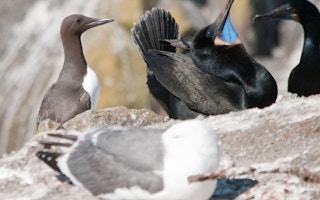For a tern in the northern hemisphere, life may be about to take a turn for the worse. For murres or guillemots, as the temperature rises, the chance of survival takes a dive. Many of the world’s seabirds could be in trouble.
And for a mix of reasons, the birds of the southern hemisphere could also be heading into difficulties, but at a slower pace. A worldwide team of 40 ornithologists has looked at 50 years of breeding records for 67 seabird species to find that as global temperatures notch up, breeding rates are down.
That may be just an indicator of deteriorating conditions on and below the surface of the oceans: the researchers call their seabird subjects “ecosystem sentinels”.
The scientists report in the journal Science that they used their data to test a proposition: that seabird productivity − the numbers that survive each breeding season − would track “hemispheric asymmetry” in ocean climate change and human use.
Put simply, because there is less land and fewer people south of the Equator, because the southern waters are less overfished and subjected to lower pollution levels, and because a bigger ocean space ought to absorb extremes of heat more effectively, seabird survival rates would be worse north of the line than to the south.
And that is because the fish and plankton that seabirds eat can move with the climate, but the seabirds cannot: during the breeding season, they return to the same colonies.
“
They have to compete with us for food. They get caught in our fishing nets. They eat our plastic, which they think is food. All of these factors can kill off large numbers of long-lived seabirds.
P. Dee Boersma, conservation biologist, University of Washington
And hunt they must: the species Uria aalge, known as the murre or the guillemot, must eat half its bodyweight in fish each day to survive. When a long-term marine heatwave hit the north-east Pacific in 2015-2016, almost a million of them starved to death.
Breeding colonies also suffered. The pattern of change is not uniform: surface-feeding birds were more likely to be in decline; birds like puffins that plunged below the surface tended to fare a little better at rearing offspring to survival.
“Seabirds travel long distances — some going from one hemisphere to the other — chasing their food in the ocean. This makes them sensitive to changes in things like ocean productivity, often over a large area,” said P. Dee Boersma, a conservation biologist at the University of Washington in the US.
“They have to compete with us for food. They get caught in our fishing nets. They eat our plastic, which they think is food. All of these factors can kill off large numbers of long-lived seabirds.”
She and colleagues have monitored the breeding success of a colony of Magellanic penguins in southern Argentina for 35 years. These birds go back to the water each season to feed their chicks: the further they have to swim, the greater the chance of a starved penguin chick.
Competition for food
Stormier weather on land, too, can destroy nests. Female penguins find survival tougher, and are more likely to die at sea. So the proportion of male Magellanic penguins is rising. Today the breeding population at the research site is about half of its numbers 40 years ago.
William Sydeman of the Farallon Institute in Northern California, who led the study, warned that falling seabird numbers could be an indicator of worse things happening at sea.
“What’s also at stake is the health of fish populations such as salmon and cod, as well as marine mammals and large invertebrates, such as squid, that are eating the same small forage fish and plankton that seabirds eat,” he said.
“When seabirds aren’t doing well, this is a red flag that something bigger is happening below the ocean’s surface which is concerning, because we depend on healthy oceans for quality of life.”
This story was published with permission from Climate News Network.

















